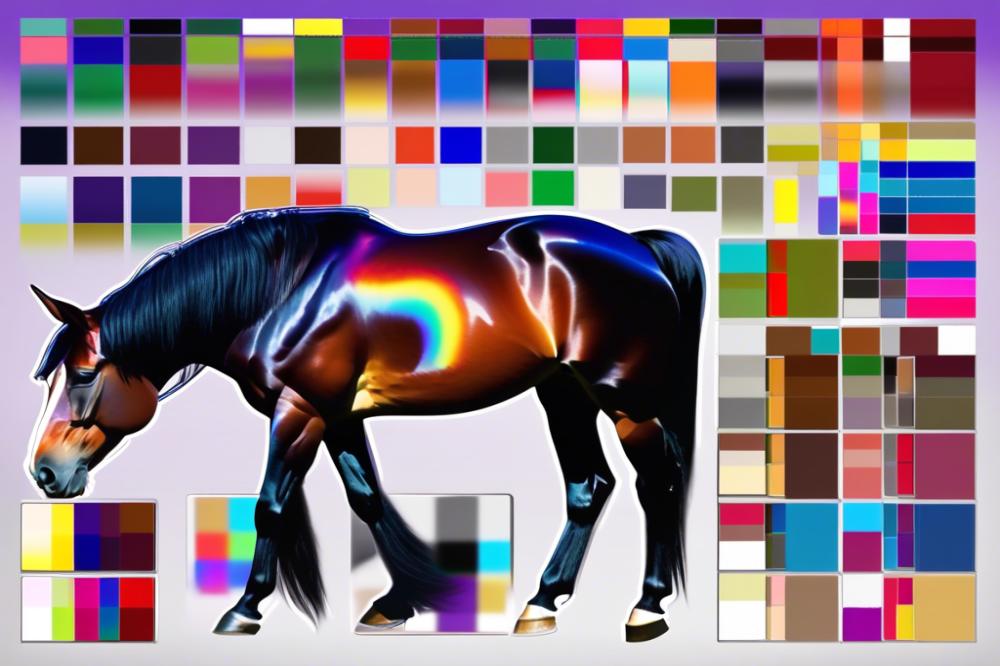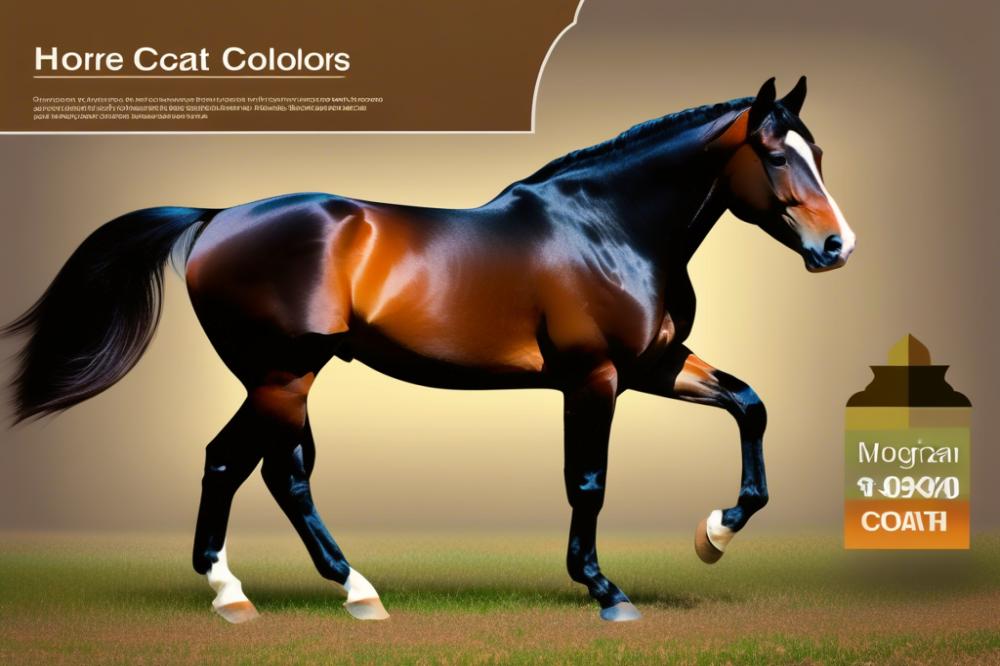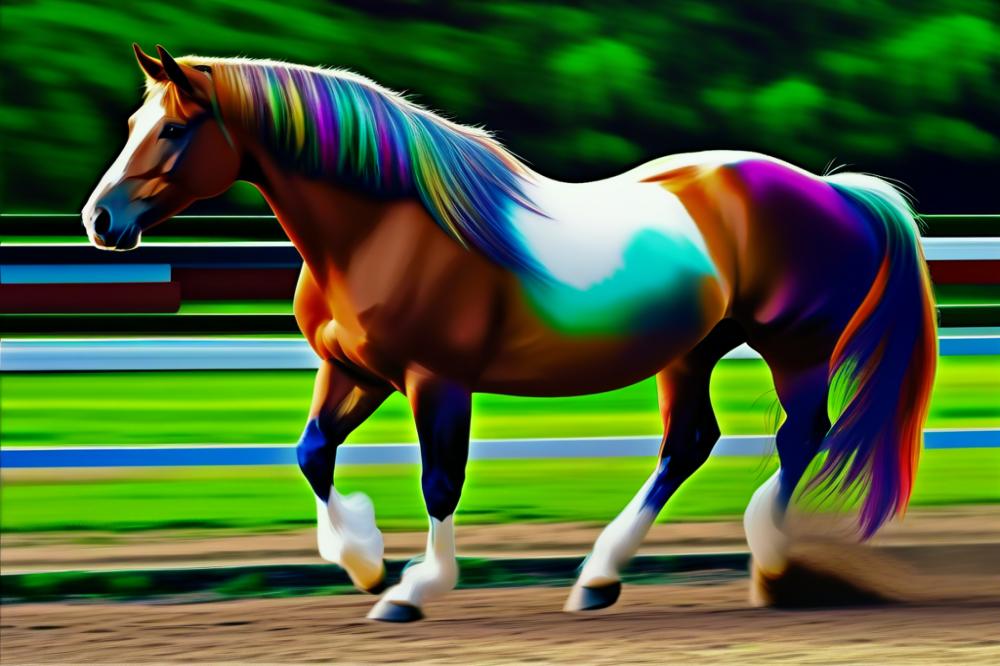Getting to Know the Morgan Horse
The Morgan horse is much more than just a pretty sight on the farm. Known for their friendly demeanor and strong work ethic, Morgans have been beloved companions for many years. With roots tracing back to the early 19th century in the United States, this breed is celebrated for its endurance and versatility. Whether galloping through a meadow or trotting in a show ring, these horses showcase an incredible balance of spirit and elegance. It’s no wonder they have earned a spot in the hearts of horse lovers everywhere!
Why Coat Color Matters

When considering the overall appeal of a Morgan horse, coat color plays a significant role. For many enthusiasts, the shades and patterns of horse coat colors can speak volumes about an individual horse’s personality and heritage. Each color has its own charm. Some may prefer the deep chestnut tones, while others get captivated by the glossy black coat. This variety not only highlights the breed’s beauty but also reflects the rich equine characteristics that make Morgans so special.
What You’ll Find Here

This article will delve into all things Morgan horse coat colors. You’ll discover fascinating facts about various shades within the breed and the distinctive traits associated with them. Additionally, we’ll explore horse breed information, including some care tips that can help keep these beauties healthy and happy. Ever wondered about amusing tidbits related to horse care, like can a horse eat celery? We might touch on that, too!
As you read on, we encourage you to embrace the nuances of Morgan traits and appreciate the layered meaning behind each coat color. After all, looking at a shining bay Morgan or a dapple grey is like seeing a work of art come to life. So grab your favorite snack, perhaps some horse treats (no, not for you!), and settle in as we paint the vivid picture of Morgan horse colors together.
History of Morgan Horse Colors

Origin and Development of Morgan Horses
Morgan horses trace their roots back to the early 19th century in the United States. They were named after a remarkable stallion called Justin Morgan. This horse was not just any equine; he was known for his strength, speed, and gentle nature. Moragans were bred for various tasks, including pulling carts and working on farms. Over time, their versatility caught the eye of many horse enthusiasts. The blend of traits from different horse breeds truly shaped their character.
Early Breed Standards and Coat Color
In the early years, people noticed that color wasn’t the main focus when breeding Morgans. They looked more closely at the horse’s abilities and temperament. However, some coat colors stood out. Bay was popular, thanks to its striking warmth. Chestnut and black were also common. Many horse enthusiasts took note of these colors, and breed standards began to form. These standards didn’t just mention performance; they also described acceptable coat colors. This helped create an overall identity for the breed.
Influence of Various Breeds on Color Variations
Morgan horses didn’t become extraordinary on their own. They mingled with many different horse breeds, picking up traits along the way. Some influence came from Thoroughbreds, adding flash to the Morgans’ appearance. Arabian horses lent their elegant bodies and finer coats, which enhanced overall beauty. Each influence contributed to a wider range of coat colors and patterns. Some buyers now especially seek out particular shades and markings. This variety keeps things interesting in the world of horse care and breed information.
When you look at Morgan horses today, you can see how rich their history really is. Each color tells a part of their story, from strength in labor to beauty in style. That connection helps keep the spirit of these horses alive, no matter which color they wear.
Common Morgan Horse Coat Colors
Morgan horses are delightful companions and come in a variety of stunning colors. Each coat color reflects the horse’s unique personality and can vary widely, even within the same color family. Let’s dive into the most prevalent options found in this remarkable breed.
Bay
Bay is a popular color among horse breeds. This shade often appears as a warm reddish-brown, complemented by black points on the mane, tail, and lower legs. Some display subtle variations, like a deep mahogany hue, while others might lean towards a lighter, golden tone. This color is striking, especially when the sunlight catches the glossy coat.
Black
Black Morgans have a sleek and shiny appearance. Their coat can be deep and dark, sometimes showing a blue or brown tint, depending on the light. A true black horse stands out in any crowd. Their sharp, equine features are enhanced by the richness of their coat color. It’s not uncommon to see some black horses with lighter shades around their muzzle or eyes.
Chestnut
Chestnut coats range from a light amber to a deep copper. They shine with a warm glow that can make them look almost golden in the sunlight. Many of these horses have a flowing mane and tail that often match or enhance their coat color. Interestingly, you might encounter variations like sorrel, which is a lighter, more vibrant form of chestnut. Overall, these colors create a soft and inviting look.
Other Colors
Beyond bay, black, and chestnut, Morgan horses can also surprise you with other lovely colors. There are gray Morgans, ranging from a pure white to deeper shades, creating a striking contrast against their darker skin beneath. Buckskin is another favorite, combining a light tan coat with black points. Paint patterns are also seen in this breed, featuring splashes of white and another color, creating a colorful patchwork. Each coat color presents its own charm and tells a story.
Visual Characteristics and Variations
When discussing horse coat colors, it is essential to understand the variations. No two horses are alike, even within the same color category. For instance, a bay horse could be light and bright, while another might be dark and rich. Likewise, with a chestnut, some may appear deeply red, while others lean more towards brown. There’s a whole world of shades and hues within these colors, highlighting the horse’s individuality and genetic makeup.
All these aspects are part of the Morgan traits that horse lovers admire. Variations can reflect a horse’s lineage and background. So, when looking into horse breed information, consider how these beautiful colors contribute to the overall allure of the breed. Remember, horse care involves more than just feeding and grooming. It also means appreciating their gorgeous coats and diverse colors!
Rare and Unique Coat Colors
When it comes to coat colors in Morgan horses, some shades really stand out. These rare colors can capture anyone’s attention. While most people think of the classic bays or blacks, there are some striking variations to discover.
Analysis of Less Common Morgan Horse Colors
A few colors are certainly less common within this horse breed. For instance, some Morgans can show a lovely grey coat. This grey can spark various tones, ranging from light to dark. Another surprising color is the champagne, which gives off a dazzling, golden glow. Not to forget, we also have the roan, a shade that mixes white hairs with the base color. Each of these coat colors contributes to the overall beauty and diversity of Morgans.
Dilutions Such as Palomino and Buckskin
Many Morgans are also seen with diluted colors. Palomino, for example, is a bright gold that brings to mind sunny days and beautiful fields. Likewise, buckskin horses display a striking tan coat with a distinct black mane and tail. These dilutions arise due to specific genetic factors. Parents can pass on these lighter colors like a family treasure, but they don’t appear in every bloodline.
Genetic Factors Influencing Rare Colors
Understanding genetics can be quite fascinating when it comes to coat colors. The color of a horse originates from its parents, much like the color of your eyes comes from your family. Certain genes are responsible for those rarer shades. It’s almost like a puzzle where each piece matters. Some combinations might lead to dazzling colors, while others do the opposite. Horse breed information helps discover these magical genetic links. When it comes to breeding, enthusiasts often aim for specific equine characteristics. Mapping out a horse’s lineage adds layers to predict the possible coat colors that might arise.
Color Genetics in Morgan Horses
Basic Principles of Equine Coat Color Genetics
Equine coat colors come from genetics, just like our hair and eyes. Horses have specific genes that determine their colors. These genes work together to create a beautiful variety of shades. In simple terms, each horse inherits genes from its parents. Together, these genes mix and mingle. This mixing leads to the coat colors we see. Some colors are common, while others are rare. Understanding the basics can make horse breed information more fascinating.
How Coat Color Inheritance Works in Morgans
Morgan horses are known for their strength and kind nature. They come in various coat colors, thanks to their unique genetic heritage. Coat color inheritance in Morgans involves a few important genes. One key player is the extension gene. This gene decides if a horse can have a black-based color. A dominant form of this gene will often result in black or bay coats, while the recessive form gives rise to chestnut shades.
Morgans can also carry theAgouti gene. This gene has a neat job. It determines whether a horse with a black coat will be a solid black or a bay. If the Agouti gene is present, you get bay. No Agouti means you might just have a handsome black horse strutting around.
Understanding Dominant and Recessive Traits
Now, let’s break down dominant and recessive traits without getting too bogged down in science. Dominant traits are a bit like the loudest kids in the class. They show up even if only one parent has the gene. On the flip side, recessive traits are like the quiet ones. They need both parents to have the gene in order to appear in the foal. When it comes to Morgan traits, if a horse has at least one dominant gene for a certain color, that color is often what you’ll see.
For example, if you have a bay parent and a chestnut parent, chances are high for a bay foal. But if both parents carry the recessive gene for chestnut, then you might just get a redhead in the mix! Using color genetics is like playing a game of chance. You can make educated guesses, but outcomes can still surprise you.
In the world of horse care, knowing these genetic details can really help breeders make informed decisions. They can mix colors with knowledge, aiming for certain equine characteristics that appeal to buyers or riders. With Morgans, the delight in discovering their hues can lead to joyful moments and, of course, some memorable photographs.
Understanding coat color genetics adds another layer of excitement to owning a horse. Imagine running your fingers through your Morgan’s mane, admiring the rich chestnut or the elegant black coat. Each color tells a story of lineage and selection. So, next time you see a Morgan, consider the genetic magic that brought those colors to life!
Impact of Coat Color on Morgan Horse Registration
Registration Standards and Coat Color Specifics
Many people assume that coat color doesn’t really matter when it comes to registration, but that’s not entirely true. Morgan horses come in a variety of colors, and some are more favored than others. Three classic shades typically seen are bay, chestnut, and black. Color, however, isn’t the only thing to consider; it’s also about meeting specific breed standards. Registries often have rules outlining acceptable coat colors. A flashy coat might not help much if it doesn’t align with established standards.
How Colors Affect Value and Market Demand
When you’re buying or selling a horse, color can play a huge role in value. People often pay more for certain shades that are in high demand. For instance, a striking palomino might catch the eye and draw a premium price. On the flip side, less common colors might not have the same market appeal. Owners should remember that coat colors can sometimes sway potential buyers. Many folks link color with equine characteristics, thinking that ones with certain shades may have better traits. It can seem a little silly, but first impressions stick around!
Relevant Breed Associations and Their Color Policies
Different breed associations have their own rules regarding coat colors. The Morgan Horse Association, for example, has specific guidelines that outline what’s acceptable. If you want to register your horse, be sure you understand those policies fully. Colors that don’t fit the mold might not be registered, no matter how handsome your horse is. Staying informed is vital for any horse owner. After all, keeping up with horse breed information can help you make smarter choices in horse care. Navigating registration can be tricky, but knowing the rules around coat colors makes it easier.
Caring for Morgan Horses of Different Colors
Considerations for Grooming Based on Coat Color
Taking care of horses means understanding their coat colors. Dark coats, like black or bay, can show dust and dirt more easily. When grooming these vibrant shades, it’s good to use a soft brush to get rid of any debris. Light-colored horses, such as palominos or cremellos, might need extra attention to avoid sunburn. For them, using UV protection sprays can be a lifesaver during sunny days.
Each coat color has its quirks. For example, chestnut Morgans can sometimes have a reddish tint that reflects the light. Regular grooming helps keep their coats glossy. Additionally, pay extra attention to areas prone to sweat. This will help prevent skin issues.
Best Practices for Maintaining Bright and Healthy Coats
Nutrition plays a huge role in maintaining these coats. A balanced diet filled with vitamins and minerals is essential. Omega-3 fatty acids can work wonders for maintaining shine. It’s like giving your horse a spa treatment from the inside out!
Daily grooming is not just for looks; it’s also a bonding time. Horses feel loved when you take the time to brush them. Plus, it helps reduce their stress. Use a curry comb first to loosen dirt, then follow up with a soft brush for a shiny finish. Don’t forget to check for any knots or tangles. Regular hoof care is also vital, since a well-groomed horse has a better overall appearance.
Seasonal Care Tips
The changing seasons bring different grooming challenges. In winter, longer coats can trap mud and dirt. Regularly checking your horse for clumps of dirt helps keep the coat looking fresh. It might take a bit longer to groom, but a good scrubbing will keep them comfortable and clean.
During summer, flies can be a nuisance. A good fly spray can save the day! Applying a coat conditioner helps repel insects while keeping the coat smooth. You might even want to give them a bath more frequently. Bathing a Morgan with a colorful coat can produce quite a show!
Don’t forget about hydration. Fresh, clean water keeps their skin healthy. Providing shade during the hottest parts of the day is key to maintaining any horse health.
When it comes down to it, knowing these equine characteristics is crucial for care. Different horse breeds have various needs, so always be attentive. Keeping an eye on coat colors and adjusting care routines can make a world of difference. After all, a happy horse means a happy rider!
Wrapping Up the Colors of Morgan Horses
When it comes to Morgan horse colors, there’s a whole rainbow to explore! These beautiful animals come in shades ranging from deep bay to elegant grey, making each one a standout in its own right. Remember, each color has its own story and history, adding to the charm of this beloved breed. You might even find yourself drawn to a particular hue that just catches your eye—like how some folks get attached to their favorite horse movie characters!
Diving into color genetics can feel a bit like cracking a code. Understanding how genes work helps us appreciate why some Morgans flaunt a shiny black coat, while others wear a rich chestnut. Learning about their genetics is not just about aesthetics; it also teaches us about health and behavior in horses. So, whether you’re aiming to create the next big show star or simply want a faithful trail companion, knowing the coat color traits could give you the upper hand.
For those thinking about welcoming a Morgan into their lives, why not also consider the colors that go along with the breed? Exploring different shades may bring spark to your search or even help you form a bond with your new friend. Maybe you’ll find yourself in a sunny field, realizing that your pal’s coat color is the one you never knew you wanted. And let’s not forget about the fun of showing off those english vs western reins, which can complement any coat beautifully!
In conclusion, every Morgan horse is a character in its own right, and their colors are just one part of the unique tapestry that makes them so special. Don’t hesitate to dive deeper into the fascinating world of horse colors. You never know what you might discover about yourself along the way! So go ahead, take the plunge into exploring these noble creatures, and find the perfect equine friend who resonates with your personality and dreams.



